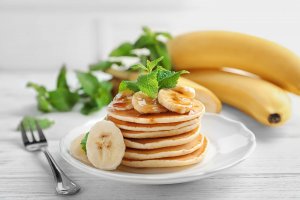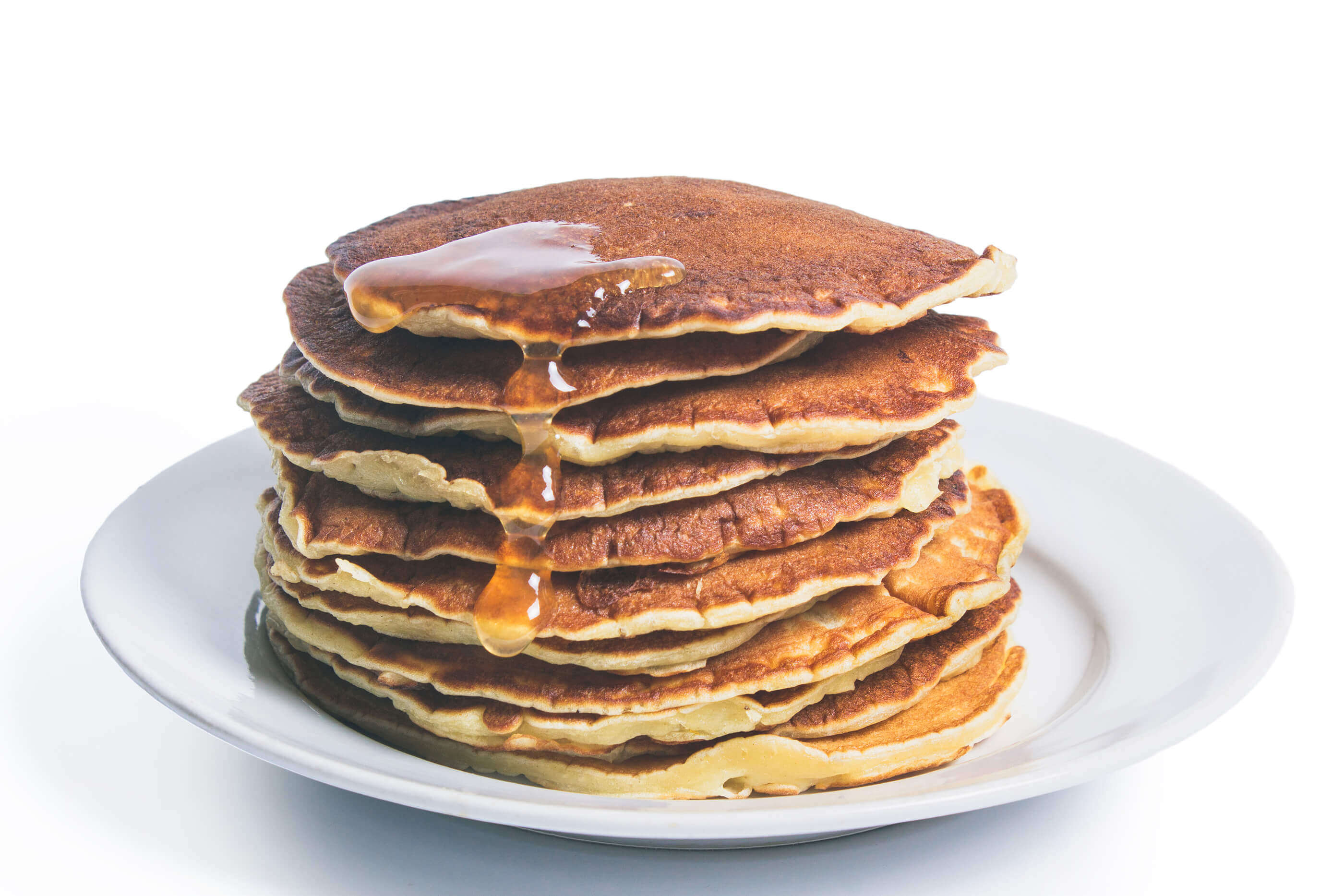February is the month that brings us the love and warmth of Valentine’s Day, but does it get any batter than Pancake Day? Flinging that all-so-indulgent mix of milk, eggs, and flour from the pan into the air — it feels like a day of celebration.
This tradition of eating pancakes on Shrove Tuesday comes from the need to use up rich and luxurious high-fat foods before the fasting season of Lent begins on Ash Wednesday.
Whether you’re a crepe connoisseur or prefer to feast on the thick and fluffy American-style pancakes, you would think no Pancake Day waste would be left unturned. Yet many end up flipped on the floor, burned, or undercooked, and that’s ignoring the inevitability of the first pancake feeling a little sorry for itself.
Finding lumps of flour or eggshell in the mix or simply making too much mixture are also common problems, resulting in all those batter-based dreams being tossed away. In 2023, it was estimated that over 25 million pancakes would be classed as inedible in UK households — a far splatter from their zero-waste origins.
We’ve rummaged in the back of our cupboards and found some green Pancake Day tips to share with you so you can devour your pancakes (sweet or savoury) without the waste.
How to save your first pancake
Nearly a third of households claim their first pancake is always bad, so they use it as a practice run. It’s difficult not knowing if the pan is hot enough, whether the batter is the right consistency, or if there’s enough oil in the pan.
Even if your “test” pancake doesn’t go as planned, you can still stop it from ending up as food waste. Here are some ways to make it just as appetising as the following pancakes.
Get your batter, oil, and heat right
Henrietta Inman, a Lanesborough-trained pastry chef, cook, and baker at Wakelyns Farm, explains that “it’s all about getting the pan used to the mix, and warming it up for the rest.”
Once your batter is made, let it rest so the gluten relaxes. Around 20 minutes is fine.
You’ve then got to get your pan suitably oiled (you can also use butter instead). We recommend using spray oil as it makes evenly coating a frying pan much easier than using pouring oil.
Don’t use too much butter or oil, as your “sacrificial” pancake will soak up the fat, leaving you with a greasy, soggy pancake. Before adding the batter to the pan, the butter or oil must be very hot but not smoking. A classic oil swipe with a reusable cloth or kitchen towel is also wise before pouring in your batter.
Finally, you’ve got to be patient with your heat. High heat doesn’t cook pancakes faster. It burns the outside, and the batter on the inside will be undercooked. Put it on medium heat before you add any fat, and for long enough to ensure an even heat distribution.
If your first pancake is cooking too fast but isn’t ready to flip, take if off the heat for a minute and go again. Consider turning the temperature down a touch so it cooks more evenly and slowly.
Start small
There’s no harm in accepting your first pancake or two will be a flop, so why not start small to leave less room for error and reduce batter waste. Familiarise your pan with the mix by creating tiny baby pancakes rather than pouring a large one that will end up unevenly cooked.
Use the right pan
If you don’t use the right pan, your first pancake will end in disaster. Look for pans with a durable, non-stick coating — an ordinary frying pan won’t stack up. True pancake aficionados can always upgrade to a specialist pancake pan to take their pancakes to the next level.
Top it up
Turn your first pancakes from flat to fabulous with your favourite toppings. Whether you are nutty for Nutella, bananas for bananas, or a sucker for something more savoury, any pancake can be rescued with a topping or two. Mop up any excess oil by gently placing an absorbent cloth on your pancake, before smothering it with joy.
Low waste Pancake Day toppings
So many fruits, vegetables, meats, and cheeses taste amazing on a pancake, but there’s no need to go over the top with perishable toppings or ingredients you won’t use again.
Fresh produce like spinach, smoked salmon, raspberries, and blueberries all complement a pancake, but will you use them in the coming days before they go mouldy or slimy?
You’ve probably already got some delicious options in your store cupboard or items you would never think to pair with your pancakes. Try these for inspiration:
- Yoghurt that needs to be used up can be added to your batter for a thicker mix, contributing to an ultra-fluffy texture. Alternatively, use it as a topping alongside mixed berries and a drizzle of honey to ooze flavour and moisture to your stack.
- Make a caramel sauce by bringing a tin of condensed milk near its best-before date to the boil.
- Swap your dunkers for decoration by scattering crushed, soft digestive biscuits over your pancakes for a delightful textural topping.
- Make a sumptuous compote by heating up your soft fruits and spreading it over your pancakes.
- Have you ever considered a pancake pizza? Grab a jar of leftover salsa, a tube of tomato puree, or any tomato sauce you’ve made. Sprinkle on some cheese and any other toppings you have lying around — ham, mushrooms, peppers, etc. Grill it until the cheese is bubbling and the topping is cooked through.
If you want to avoid perishable toppings altogether, opt for something that guarantees extra longevity. Items like jam, Nutella, Biscoff spread, maple syrup, and nuts all boast solid shelf lives.
Sustainable ways to use up or get rid of pancake ingredients
Your pancakes wouldn’t taste the same without key ingredients such as eggs and milk, but there are plenty of eco-friendly disposal methods available, rather than chucking them in the bin.
Egg shells
Eggs are a vital part of any pancake mix, which inevitably means you’ll be left with a lot of shells. These shells can be placed in your kitchen caddy or recycling container, but they can also be crushed up and added to your compost heap. They quickly decompose and supply the soil with valuable calcium and other minerals.
Eggshells also make an excellent deterrent for slugs and snails, preventing them from chomping on your garden plants. Crush them and scatter them around your foliage to keep those pests at bay.
Milk
A good splash of milk is integral to a batter’s flavour and texture. If you’ve got too much milk, you can freeze it in a freezer-safe container if it’s not past its best-before date. If it has passed this point, you can still use sour milk in milkshakes, scrambled eggs, and recipes that call for buttermilk.
Lemon skins
You can’t beat a good old-fashioned pancake — thin and golden brown with a sprinkling of sugar and freshly squeezed lemon. This much-loved topping can also be used on your compost pile. A few lemon skins will suffice, otherwise the compost can become overly acidic. The plants and worms won’t thank you for it, either.
Lemon zest is great for baking (lemon drizzle cake, anyone?) and creating candied lemon peel. You could dry out the skins to bring a calming lemon scent to your homemade potpourri.
Bananas
Sliced bananas are another classic pancake topping, but any leftovers can become overripe quickly. Mashing some into the batter, baking banana bread, or using them as a base for a healthy, homemade smoothie are tasty ways to stop one of the UK’s most wasted foods from going to waste.
Bananas and their peels are also a great addition to your compost or worm farm, contributing to a nutrient-rich organic recycling process.

Batter
Made too much batter? Transfer it into an air-tight container or a bowl covered in clingfilm and put it in the fridge. Check the expiry date listed on your eggs and milk, and it should be good for two to four days. You’ve then got a yummy batter you can use for meals in the coming days. Think onion rings, a lunchtime ham, cheese, and spinach crepe, or whipping up gloriously golden Yorkshire puddings.
The freezer is also a viable option for your excess pancake batter. Dispense it into a container or ziplock bag and pop it in the freezer. If using a ziplock bag, remove as much air as possible and flatten the pouch. The flatter and thinner the mixture, the quicker it thaws when you’re ready to make more pancakes. Place it in a clean bowl and leave it in the fridge overnight to defrost. A clever little hack is cutting off a corner of the bag and piping the mixture directly into the pan — pouring the batter doesn’t get much easier.
Top tips for an eco-friendly Pancake Day
Let’s explore other ways to ensure less waste and more pancakes.
- Avoid readymade pancake mix by making your batter from scratch. This will reduce the amount of packaging waste used and give you the satisfaction of learning a great life skill.
- Calculate your pancake percentages sensibly. Remember measuring jugs and scales are your friends, so use them to portion how much batter you make. Typical pancake recipes afford 25-30g of flour per person for two medium pancakes each.
- Do you even need to go to the shops? Take a peek in the pantry and fridge to see what ingredients you already have in stock. Most households already have pancake staples like flour, sugar, eggs, and milk, and jam, honey for toppings.
- Make a list of what you need from the shops to avoid buying more than you need. Consider shopping at a zero-waste store, where you can bring your empty jars and containers to refill them with your pancake essentials.
- Leftover pancakes can be wrapped in foil and kept in the fridge for up to one week. If you’ve made a massive stack of pancakes, you’re better off putting them in the freezer on a layer of greaseproof paper between each one.
A change for the batter?
Pancake Day will soon crepe upon us. For many, it evokes a certain kind of crowd-pleasing nostalgia. But all this excitement surrounding Shrove Tuesday often means food goes to waste.
Whether it’s using milk in glass bottles, buying locally-sourced honey, or keeping your portion sizes under control, let’s work together to bring the original use-it-up food back to its former glory.
